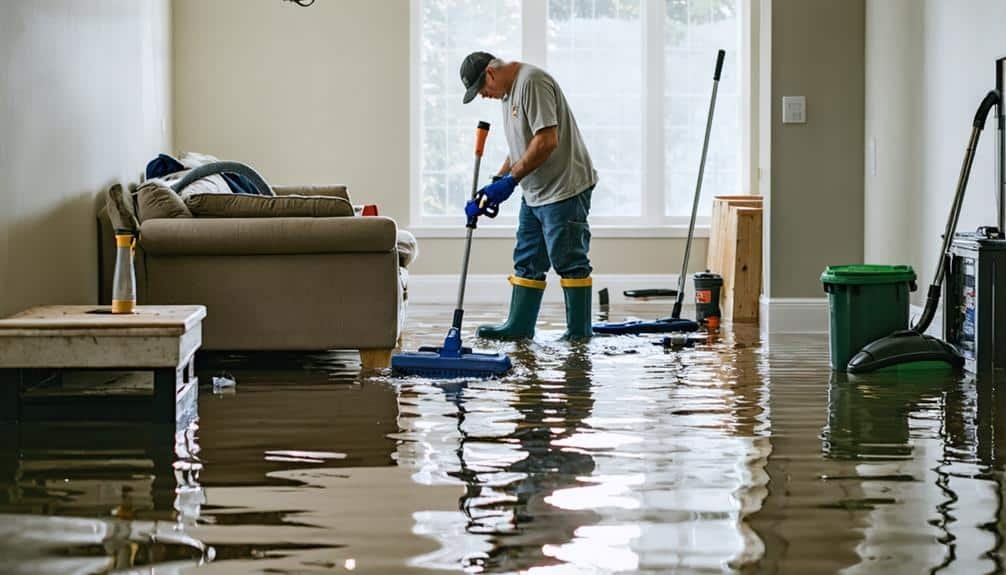In an emergency water damage situation, your first steps are critical. Start by evaluating the damage and identifying the water source. Verify your safety by turning off electricity and gas. Remove any standing water using a wet/dry vacuum or pump, wearing protective gear if necessary. Next, dry and ventilate the area by opening windows and using fans. Document all damage with photos and notes for insurance purposes, including a detailed inventory of affected items. Acting swiftly can minimize loss; there's much more to reflect on as you move forward with cleanup and restoration efforts.
Assess the Situation

When you're faced with water damage, the first step is to assess the situation thoroughly. Start by evaluating the damage to determine the extent and source of the water intrusion. Look for visible signs like wet walls, floors, and ceilings. Pay attention to hidden areas, such as behind cabinets or under carpets, where moisture may accumulate. It's additionally vital to identify the water source to determine the contamination level and the necessary remediation steps, whether it's a roof leak, plumbing failure, or flooding that requires assessing and documenting damage.
While you're evaluating, it's imperative to implement safety precautions. Make certain you're wearing protective gear like gloves and boots to avoid exposure to contaminants. If the water is coming from a source you suspect could be hazardous, like sewage, take extra care. Avoid any areas where electrical hazards may exist, and if necessary, keep a safe distance until you can turn off utilities.
Document everything you find with photos or notes. This information will be invaluable for insurance claims and restoration efforts. By taking a methodical approach to assess the situation, you empower yourself to make well-informed choices on the next steps. Remember, quick action can greatly reduce long-term damage and lead to a more successful recovery.
Turn Off Utilities
Turning off utilities is a crucial step in managing water damage. When you encounter flooding, your first priority should be safety. Water can compromise electrical systems, leading to potential shocks or fires. Before you wade into any affected areas, make sure you turn off the electricity at the main breaker. This action helps prevent electrical hazards and protects your utility service. Furthermore, it's important to assess any visible damage before proceeding, as this can guide your next steps and document damage for insurance claims.
Next, if water is rising or has infiltrated your home, shut off the gas supply as well. Gas lines can be vulnerable during flooding, and turning them off minimizes the risk of leaks, which could result in dangerous situations.
Always wear rubber-soled boots when working around water to maintain safety precautions. If you're unsure about turning off utilities yourself, contact a professional. They can assist with safely disconnecting services while making sure your home remains secure.
Lastly, document any damage for insurance purposes before proceeding with further cleanup. Properly managing utilities is crucial in safeguarding both your health and property during a water emergency. Taking these important steps can provide you with peace of mind as you navigate through the cleanup process.
Remove Standing Water

After confirming your utilities are turned off, the next essential step is to remove standing water from your property. This process, known as water extraction, is vital to prevent further damage and mold growth. Quick actions to mitigate water damage can greatly reduce the risk of long-term issues. Start by evaluating the extent of the flooding. If the water is shallow, you can use a wet/dry vacuum to extract it. For deeper water, consider a pump rental. Submersible pumps are effective in quickly removing large volumes of water.
Position the pump in the deepest area and verify it's properly connected to a discharge hose that directs water away from your home. If you're dealing with contaminated water, wear protective gear, including gloves and boots, to safeguard your health.
In situations where the water is too extensive or the equipment is unavailable, it's wise to call in professional water damage restoration services. They have the expertise and specialized equipment to handle considerable water extraction safely and efficiently.
Act swiftly—every moment counts when dealing with standing water. By removing it promptly, you'll mitigate damage and help protect your property from long-term issues.
Dry and Ventilate
Once you've removed standing water, drying and ventilating the area is crucial to prevent mold growth and further damage. Start by maximizing air circulation. Open windows and doors to promote airflow, and use fans to direct moisture-laden air outside. Proper dehumidifier placement is critical; position it in the most affected area to extract moisture efficiently.
Utilize the following table to guide your drying process:
| Action | Purpose |
|---|---|
| Open windows and doors | Increase air circulation |
| Use fans | Direct airflow to damp areas |
| Set up dehumidifiers | Remove excess moisture |
| Check humidity levels | Monitor drying progress |
| Rotate furniture | Prevent moisture absorption |
Document Damage

Documenting damage is essential for effective water damage cleanup and insurance claims. As soon as it's safe, grab a camera or your smartphone to take clear photographs of the affected areas. Capture the extent of the water damage, including structural elements, personal belongings, and any visible mold or mildew. These images will serve as important evidence for your insurance coverage.
Next, create a detailed inventory list of damaged items, noting their condition and estimated value. This documentation will help restoration services assess the situation accurately. Be specific about the damage; include dates and times when the incident occurred, alongside any actions you took immediately after the event.
Keep all receipts related to the cleanup process, including those for temporary repairs or professional restoration services. These records can greatly impact your insurance claim. Don't forget to contact your insurance provider promptly to report the incident and provide them with your documented evidence. This proactive approach not only speeds up the claims process but also guarantees you receive the compensation you deserve for the damages incurred.
Conclusion
In the face of water damage, acting swiftly is essential. Did you know that about 14,000 people experience a water damage emergency each day in the U.S.? By evaluating the situation, turning off utilities, removing standing water, and ensuring proper ventilation, you can greatly mitigate the damage. Documenting everything for insurance claims is just as vital. Remember, quick action not only protects your property but likewise helps prevent long-term issues like mold growth. Stay prepared and informed.


0 Comments